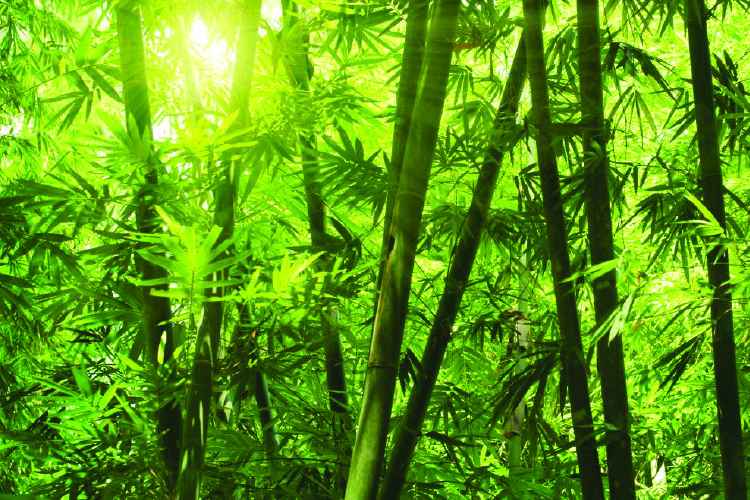September 18th is World Bamboo Day. Why on earth would people want to celebrate a plant?
The short answer is, it’s a great plant. For one thing, it’s highly versatile—a recent British Broadcasting Corporation article states that bamboo can be used in around 1,500 ways, from construction material and furniture to food and bicycles. No wonder people are calling it the “new super material.”
Table of Contents
Bamboo can be turned into fabric too. And this is what this story is about.
Comfy, comfy, comfy
Bamboo is yet another great clothing material. To start off, bamboo is soft. I may sound like a broken record to regular Natural Health readers—this is soft, that is soft. I admit—I am obsessed with softness. That’s because I’m in the innerwear business, where softness is a critical factor. So please indulge me one more time.
Secondly, bamboo has great wicking properties. Wicking means the drawing away of moisture (e.g. sweat) from the skin. And bamboo can do this much faster than cotton—up to four times faster, according to one source. This enhances the comfort factor.
Thirdly, because of its fibre structure, bamboo has a great ability to “breathe.” When a fabric is said to be breathable, it means it can admit air to the skin and allow sweat to evaporate. Breathability is no doubt important in a hot climate like ours. It also improves the comfort factor.
UV blocker
Bamboo can block the sun’s ultraviolet rays. This is critical because continued exposure to UV rays can cause skin cancer. The phytochemical components responsible for bamboo’s UV shielding have been identified by an Australia-based research team. The same team has also shown that bamboo is 60 percent better at blocking UV rays than cotton. This is a compelling reason to wear bamboo.
Is bamboo antimicrobial?
Bamboo is said to be antimicrobial. That is, it can kill microorganisms like bacteria. This seems like a must-have factor, doesn’t it? This benefit is, however, tainted by some controversy.
That bamboo in its natural state is antimicrobial is a well-accepted fact. This naturally occurring property is commonly referred to as “bamboo kun.” But we cannot use natural bamboo for clothing. It must first be processed chemically. And this is where the controversy begins.
According to one camp, the processing destroys the naturally occurring antimicrobial property. But another camp contends that the antimicrobial property can be, to a very large extent, preserved. So who’s right and who’s wrong?
I believe both could be correct. You see, there are more ways than one to process bamboo. If the right process is used, the antimicrobial property can be preserved; if the wrong one is used, it will be destroyed. So the process is the determining factor.
I know of a company that can produce bamboo fabric that’s antimicrobial. It’s not an empty claim. This company has sent its product to a trusted independent organisation for testing, and the results show it’s telling the truth.
The preservation of the antimicrobial property could perhaps be due to the gentle Lyocell method that the company uses to produce bamboo fibre. This method is essentially similar to the award-winning Tencel way of making cellulosic fibres.
I wrote about Tencel in a previous article. I’ll just briefly summarize here the key similarities between the two methods:
- Both use a non-toxic solvent to dissolve cellulose
- Both involve a so-called “closed-loop process” that redirects waste products back into production—over 99% of the solvent is recycled, creating almost no waste.
And like Lenzing, the maker of Tencel, this bamboo fabric company is certified Oeko-Tex Standard 100, Class 1—which means its products are safe even for babies.
All in all, the Lyocell and Tencel methods lower the chemical intensity of the manufacturing process: They reduce the number of steps involved and the amount of chemical used (i.e. fewer chemicals and less harmful chemicals are used).
Now that is eco-friendly.
Green bamboo
Speaking of eco-friendliness, I must write something about bamboo’s green credentials.
Firstly, bamboo can grow very fast. It’s the world’s fastest growing plant and can be harvested annually and sustainably after four to five years. In contrast, the typical tropical hardwood takes many years longer to mature and can be harvested only once. Bamboo is also self-regenerating. This means that after the stalk has been cut, it rapidly regrows from the remaining rootstock.
Secondly, it can grow without much help—it doesn’t need much water or many pesticides. But with the demand for bamboo growing, some farmers have started to use synthetic agrochemicals to boost yield. For health reasons, it’s best to wear clothing derived from organic bamboo.
Thirdly, bamboo has an “unrivalled capacity to capture carbon,” says the BBC. A report by the UK newspaper The Guardian states that bamboo can sequester 12 tonnes of carbon dioxide (the greenhouse gas) per hectare, 30% more than trees. By the way, bamboo is technically a grass.
Fourthly, bamboo can prevent soil erosion, which can ultimately lead to landslides. Bamboo’s elaborate root system is like a net under the soil, holding everything together; so when it’s pouring the soil isn’t washed away.
My final point: You are not depriving pandas of food when you wear bamboo. The pandas eat grass bamboo, whereas the clothing industry uses moso bamboo—something the pandas don’t eat—as raw material.
So if you want to be healthy and green, wearing clothes that’s made from organic bamboo and produced in the Lyocell way is definitely one option.
















